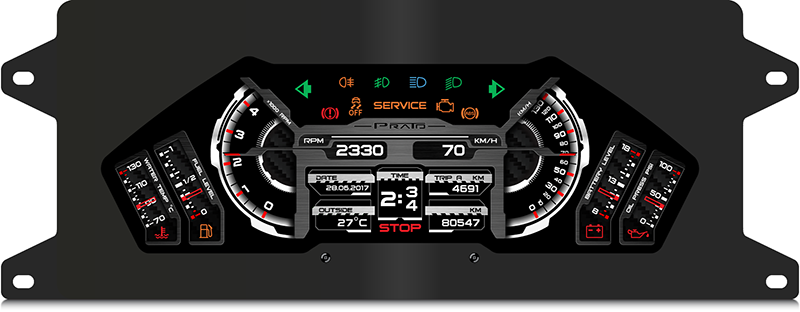| LIBROW | ® |
| Products | Solutions | Vehicles | Articles | Inquiry | Contacts | My account |
Service
Firmware for digital instrument clusters
Introduction
The spirit of the digital instrument cluster is firmware, or managing code that renders graphics and keeps the logic of things. The most important parts of the firmware are:
- 2D and 3D graphics engines
- user interface logic
- peripheral drivers
- communication engines and protocols
- real-time operation system — RTOS
2D graphics engine is responsible for picture we see in the dashboard. Final image consists of 2D pixels in the LCD, so, 2D graphics engine works on the level of elementary units of the LCD — pixels. 3D graphics engine is responsible for rendering 3D objects. Objects consist of triangles, and 3D graphics engine projects those triangles on 2D plane to get pixel image.
 Fig. 1. Digital instrument cluster graphical design — the image to be rendered real-time.
Fig. 1. Digital instrument cluster graphical design — the image to be rendered real-time.
User interface includes dialogs, controls and their logic.
Peripheral drivers are invisible forces responsible for communication between electronic components. That is how, for instance, touches are read from touch-screen: touch-screen driver reads signals from the touch-screen and converts them into events and coordinates.
Communication engines are responsible for interaction with other on-board systems of the vehicle. Important part of the communication engine is communication protocol — the set of messages used for communication.
Sometimes operation system — OS — is used. Since the dashboard is real-time device, the real-time kind of the OS to be utilized — so called RTOS.
Firmware development
Firmware development consists of four major parts:
- 2D–3D graphics engine
- graphical user interface — GUI
- peripheral drivers
- communication protocols
Graphics engine makes the digital dashboard live — it renders the final picture real-time.
 Fig 2. Digital instrument cluster is rendering the graphics from above.
Fig 2. Digital instrument cluster is rendering the graphics from above.
User interface is necessary if the virutal instrument cluster is interactive one — if user can reset trip counter and set clocks, for instance, touching virtual controls in the display.
Peripheral drivers development is of must for any digital dashboard — they manage the hearth of the cluster, SoC.
As well the communication engine is the necessary part of the instrument panel firmware — any panel collects messages from other devices, intaking status parameters for display.
Because of reliability requirements the embedded programming is done according to strict standards for embedded code like MISRA C.
Our offer
Full cycle of the digital instrument cluster firmware development
|
Other services
| Solution Manufacturing of digital instrument clusters |
|
| Service Graphical design for digital instrument clusters |
|
| Service Hardware for digital instrument clusters |
|
| Service Firmware for digital instrument clusters |
|
| Service Housing for digital instrument clusters |
|
| Solution Manufacturing of body control modules |
|
| Solution Manufacturing of power distribution modules |
|
|||||||||||||
|
|||||||||||||





